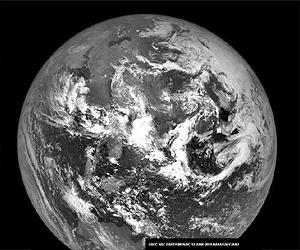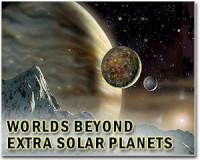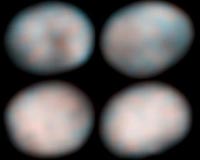|
 The Earth Is Not Round
The Earth Is Not RoundBethesda MD (SPX) Oct 19, 2010 Some 50 years ago, when the first artificial satellite was launched, it was generally thought the Earth was spherical in shape. Of course, the existence of surface anomalies such as mountains, valleys and ocean floor contours were well known, but not well understood in terms of their effects on satellite orbits near the Earth. Studies of the moon's motion had given some indication that the Earth's mass distribution is not quite spherical, but the moon is far from the planet and anomalies tend to b ... read more |
. |
|
|
Free Space, Earth, Energy And Military Newsletters - Delivered Daily |
| . | . |
| .. |
Giant, distant galaxy cluster found Cambridge, Mass. (UPI) Oct 14, 2010
Cambridge, Mass. (UPI) Oct 14, 2010 U.S. astronomers say they've discovered the biggest galaxy cluster ever seen, a massive grouping of hundreds of galaxies 7 billion light-years from Earth. Researchers from the Harvard-Smithsonian Center for Astrophysics found the cluster using the South Pole Telescope, a Harvard release said. "This galaxy cluster wins the heavyweight title. It's among the most massive clusters ev ... more Asteroid Collision Forensics  Munich, Germany (SPX) Oct 15, 2010
Munich, Germany (SPX) Oct 15, 2010In the first half of February 2009, two asteroids collided in a region of space beyond the orbit of Mars, as scientists from the Max Planck Institute for Solar System Research (MPS) in Germany have now discovered. The researchers were able to pinpoint the exact date of the impact more precisely than ever before. The debris of the crash had attracted the attention of scientists worldwide. ... more Comet watchers waiting for show  Washington (UPI) Oct 12, 2010
Washington (UPI) Oct 12, 2010 A comet rapidly approaching Earth should put on a good light show when it nears our planet and the sun in late October, U.S. astronomers say. But a NASA spacecraft will get the best view of all when it flies within 430 miles of the icy solar system wanderer on Nov. 4, ScienceNews.org reported. Comet Hartley 2 orbits the sun ever 6.46 years and will come within 11 million miles of ... more |
.. |
 Time to find a second Earth, WWF says  NASA Mission To Asteroid Gets Help From Hubble  Instant online solar energy quotes Solar Energy Solutions from ABC Solar |
.. |
|
|
Free Space, Earth, Energy And Military Newsletters - Delivered Daily |
|
|
. |
 NASA Cameras Spot Meteors From Obscure Camelopardalis Shower
NASA Cameras Spot Meteors From Obscure Camelopardalis ShowerWashington DC (SPX) Oct 12, 2010 It's a strange-sounding name for a constellation, coming from the Greco-Roman word for giraffe, or "camel leopard". The October Camelopardalids are a collection of faint stars that have no mythology associated with them - in fact, they didn't begin to appear on star charts until the 17th century. Even experienced amateur astronomers are hard-pressed to find the constellation in the night sky. But in early October, it comes to prominence in the minds of meteor scientists as they wrestle with the my ... read more |
| The contents herein, unless otherwise known to be public domain, are Copyright 1995-2010 - SpaceDaily. AFP and UPI Wire Stories are copyright Agence France-Presse and United Press International. ESA Portal Reports are copyright European Space Agency. All NASA sourced material is public domain. Additional copyrights may apply in whole or part to other bona fide parties. Advertising does not imply endorsement, agreement or approval of any opinions, statements or information provided by SpaceDaily on any web page published or hosted by SpaceDaily. Privacy statement |
| Previous Issues | Oct 18 | Oct 15 | Oct 14 | Oct 12 |